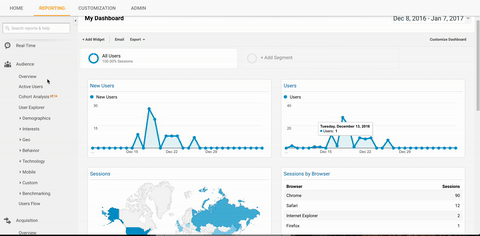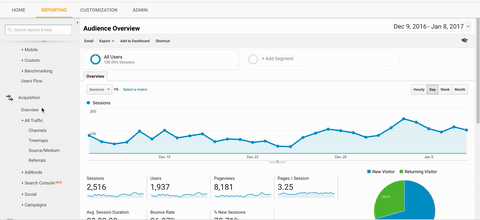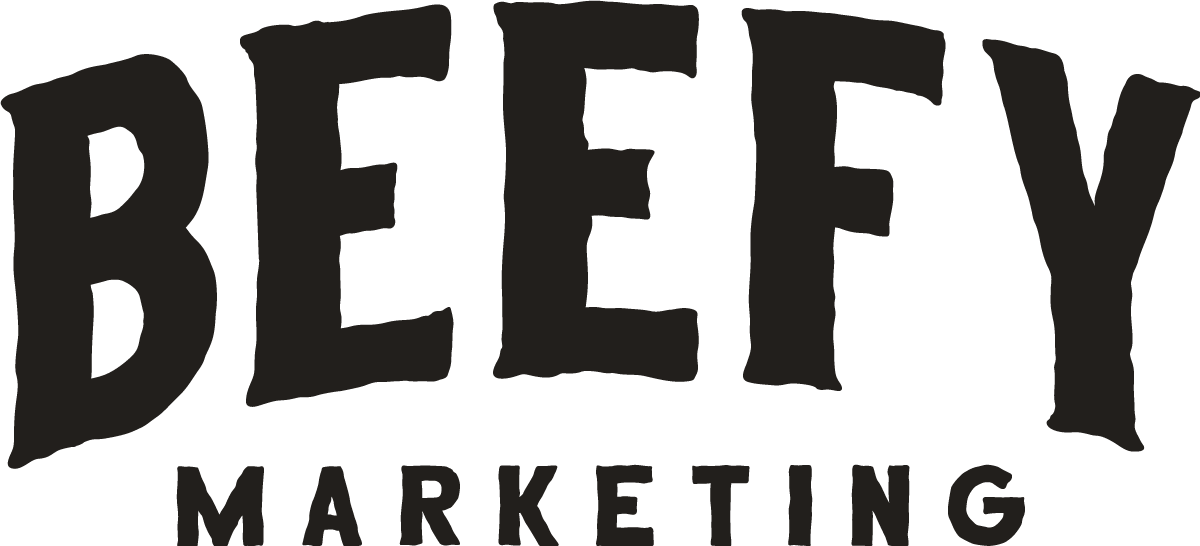Social Media Marketing is another one of those tasks that you know you need to do…
But, you don’t know if you have the time. Or even if it’s worth the effort.
After all, with an average of 500 million tweets per day, that’s a lot of competition for attention.
Social media analytics are the way that you can prove that your social media marketing actually works for your business.
Don’t fall into the trap of thinking the only metrics you need to follow are your Twitter followers or Facebook likes. Read on to find out what else you can measure – and why!
Do your social media visitors stay on your website?
Click-throughs from social media are useful to monitor. After all, people only click on links if they appeal to them. But you don’t have to stop there.
You might measure the click-through when a visitor clicks on your link on Twitter. But do you ever measure the bounce rate of that visitor?
Your bounce rate reflects how many visitors leave after viewing one page. A high rate means visitors are clicking through but leaving without moving around your site.
So they might find your website. But your content just doesn’t snag their attention.
But a low bounce rate for your visitors from social media?
That’s gold. It means visitors like what they see when they arrive.
You can track the bounce rate of four types of visitors. Those who came via ads, those who came from social media, direct visitors, and those who found you through organic search.
In your Google Analytics dashboard, click on All Traffic under the Acquisition section. Choose Channels from the drop-down menu.
The bounce rate is displayed for all four channels.

If your social media bounce rate is lower than the others, then you’re doing something right!
How much of your traffic actually comes from social?
Bounce rates aren’t the only social media analytics you can track. It’s easy to see how much traffic your site actually gets.
But, do you track how much traffic comes specifically from social media?
It’s a good idea to directly compare sources like social and organic search. Does social drive more traffic than any other source?
Again – this means your social media marketing is working.
To find this out, access your Analytics dashboard. Click on the Acquisition tab and go into the overview.
Google will show you a pie chart of the percentage of traffic coming from social, organic search, direct visits and referrals.

Do you know how much of the social voice is yours?
Lots of businesses measure mentions on social media. It’s useful to know. After all, you need to know how many people are talking about you online.
But, do you know how much you’re getting as a share for your industry? With over 50 million businesses on Facebook alone, that’s an important metric.
So you need to measure what percentage of mentions you get, and what percentage your competition gets.
You can’t use Google Analytics for this, but you can use good old-fashioned math.
You should be tracking mentions of your brand anyway. So you might have tracked 500 mentions of your brand last month.
Now you need to calculate how many mentions your competitors get. Perhaps you have six direct competitors, and they each got 400 mentions.
You’re already winning, but it’s useful to know by how much.
Add the numbers together to get the total industry mentions. In this example, that would be 2900.
Divide your percentage by the total mentions and multiply your result by 100. So you’d be getting 17% of the social voice in your industry.
But the others are only getting 13% each.
Do you know how engaged your followers actually are?
It’s easy to think that comments on your posts are the social media analytics you need to measure.
After all, if a reader is engaged enough to leave a comment then they enjoyed the content, right?
Sort of.
You need to know how many followers you had at the time to know if the comment conversion rate was any good.
After all, if you have 10,000 Facebook fans and only 4 commented, then that conversion rate is awful.
But if you got 40 comments and you only have 400 fans? Awesome!
To work this out, check how many comments you got in a specific period. You can stick to one social network, or measure all of them.
Divide the number by your number of followers in that period. Again, you can do this for one or all networks.
Multiply the result by 100 to turn the number into your conversion rate percentage.
This applies to shares too
And yes, shares of your content are also important social media analytics to know. After all, the more people share your post, the more engaging they found it.
But you can go so much further. Have a look at the ratio between the shares for each post and the number of followers you have.
So divide the number of shares you got by the number of followers you have. Multiply the result by 100.
You can do this per network or for all shares across all networks. A high ratio means more of your followers are actually interested in your content.
But you should also compare your click-throughs against your shares.
If your click-through rate is higher, that implies the visitor had a personal interest in your content.
If your share rate is higher, then it implies that someone found it interesting enough to share with their followers.
BUT there’s no guarantee the user that shared the content ever actually read it. So the click-through could be more important. That person wanted to read your content.
But be wary of vanity metrics
For the same reason, don’t just track likes or favorites. They’re essentially vanity metrics.
They don’t give you any information that can help you make marketing decisions. So you also need to track them against your overall number of followers.
So add up the number of likes your posts got in a given period. Divide that by the number of followers you had in that period.
Multiply by 100 to find out your applause rate.
Leads are the most important social media analytics of all!
All of this data is meaningless if you don’t make any actual sales.
So you need to track how many leads your social media activities are generating.
If you need help with your calls-to-action, check out these 3 strategies for the perfect CTA.
But you might track leads by sharing gated content, so visitors have to give you their email to see what you have.
You can run free demos or trials, and advertise them on social media to garner interest.
Or you could host events that visitors need to register for, like webinars or broadcasts.
Planning to use landing pages? Check out our 5 tips to turn your landing page into a money maker.
Whatever you use, just make sure that you can actually track your links. You need to know which tactics actually work.
That way you can make the most of your social media analytics. Make your marketing work for you – not the other way around!
Feel overwhelmed by social media marketing? Grab the free eBook on how to monitor your social media in just 10 minutes a day!




